
Global brands recognize that to win customers they have to connect and resonate with them through their preferred language. More and more companies are dipping their toes into the land of localization to deliver an end-to-end multilingual customer experience.
Adam Railton, Unbabel’s Head of Sales Development, shared his insights on content translation at scale, along with key trends from Unbabel’s Global Marketing Localization Report 2023, and related client examples, at the Content Marketing World, Cleveland. Adam and his team help global organizations offer localized content through every step of the customer journey: From building awareness and engagement to cementing customer advocacy.

Pedal to the localization metal
Localization at scale, says Adam, is a bit like training and completing a marathon cycle. As a keen cyclist, Adam should know, having recently completed the 1600 km journey from Land’s End to John O’Groats, the whole length of the UK. He shares that he was able to complete this trek because he had a strategy, the right tools, a good mindset, and support from friends and family: The same is needed to launch and continuously maneuver a global localization strategy at scale.
Global businesses can’t just spray and pray that their localization strategy will stick: They need the right tools, the right technology, and, Adam argues, the most important part, collaboration. Localization is not a one-person job: There are a lot of working parts and it involves multiple people to scale successfully.
Traditional approaches to translation and localization are not stacking up to the endless flows of content. These approaches are often very manual processes with limited technology and usually result in challenges with quality, speed, or scalability.
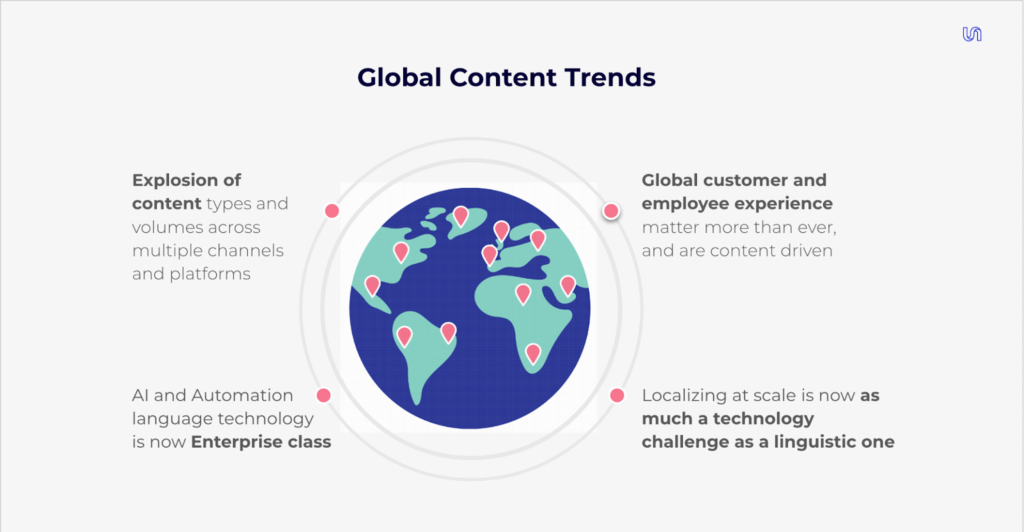
Nowadays, only 25% of internet users are native English speakers, which leaves a massive three-quarters of people who are not. So if you’re not connecting with them in their local language, how are you going to win them as customers?
Technology: Giving localization a head start
Localizing at scale is now as much a technology challenge as a linguistic one: There are a plethora of systems for content management systems, product information management, marketing, automation, and social media.
Language technology has evolved so much in the last few years, that it should be considered enterprise-class, says Adam. AI and automation are enablers to support — not replace — human productivity: It’s a complementary blend between AI systems and humans.
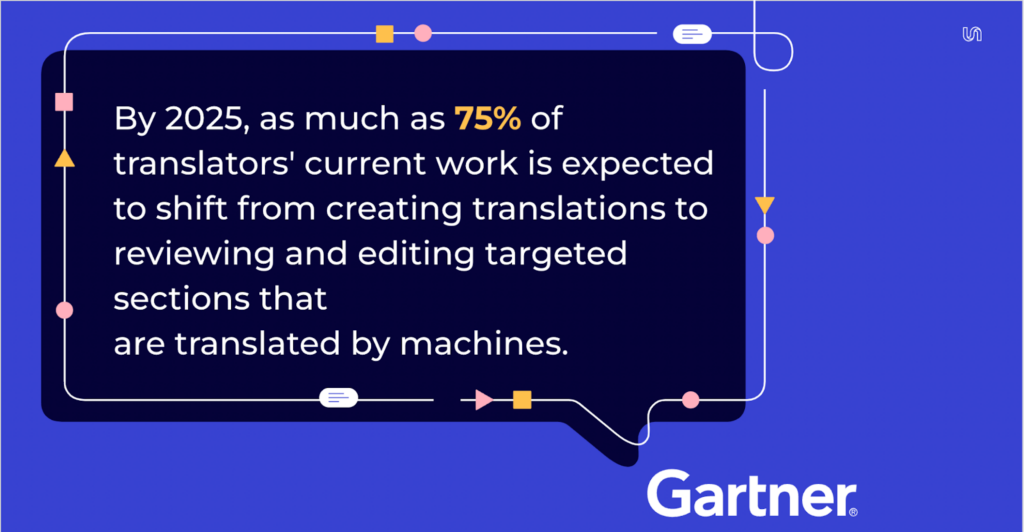
By 2025, Gartner predicts that 75% of content is going to be post-edited machine translation. Businesses will get the power of the AI component and refinement from the human element. This on its own is not necessarily the silver bullet, notes Adam, but it’s a crucial start when you consider the volume of content that businesses have to wade through and prioritize.
Shifting gears: How are global marketers handling this multilingual world?
With this growing demand for an end-to-end multilingual experience, never-ending content streams, and advances in the localization industry, Adam noted that global marketing teams have a lot to consider when adapting their content for new languages and audiences. How are these brands delivering on-brand content in different languages at speed and scale? Unbabel was keen to find out, says Adam, and surveyed 1600+ marketers across eight countries, from all manner of disciplines, and unearthed some interesting findings.
Global Marketing Localization Trends 2023: Survey audience
17% of the respondents were CMO level and 22% were senior managers, hailing from Brazil, France, Germany, Japan, Spain, Sweden, the United Kingdom, and the United States.
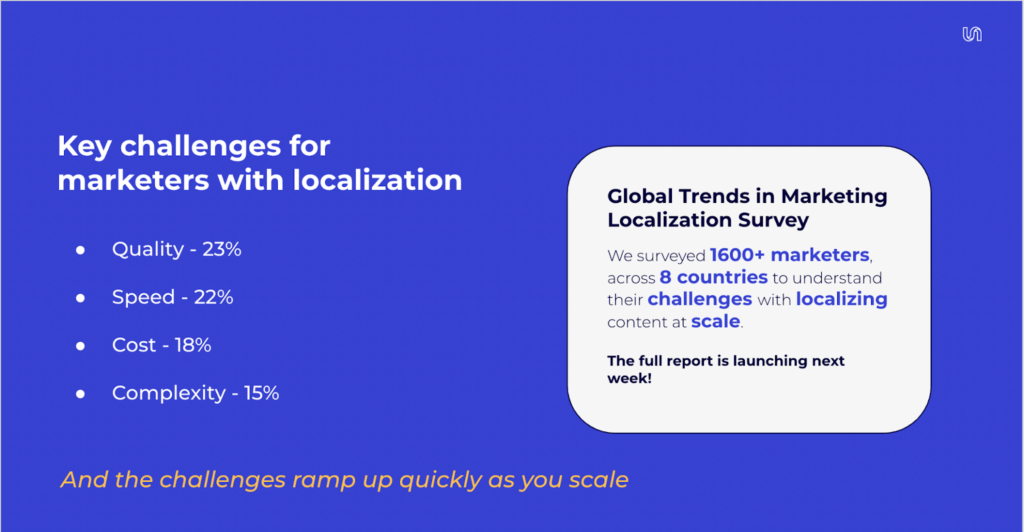
Among the questions surveyed, global marketers were asked their biggest challenge when localizing at scale: 23% said quality was the number one when delivering multilingual content. This recognition of the primary challenge is encouraging, says Adam. It shows that businesses are looking at the bigger picture and are primed to improve their localization: How can you fix something if you don’t identify it early on?
Here’s a recap of three trends from Unbabel’s Global Marketing Localization Report, and real-world client examples of these trends.
Momentum of MT
“39% of marketers are already using machine translation as part of a localization strategy, 83% of which are moderately to extremely confident in the quality.”
Ooni Pizza Ovens’ adoption of machine translation, alongside a data-driven approach and detailed assessment of terminology, resulted in a 264% growth between 2020 and 2021. This combination helped Ooni achieve — and maintain — its position as a market leader.
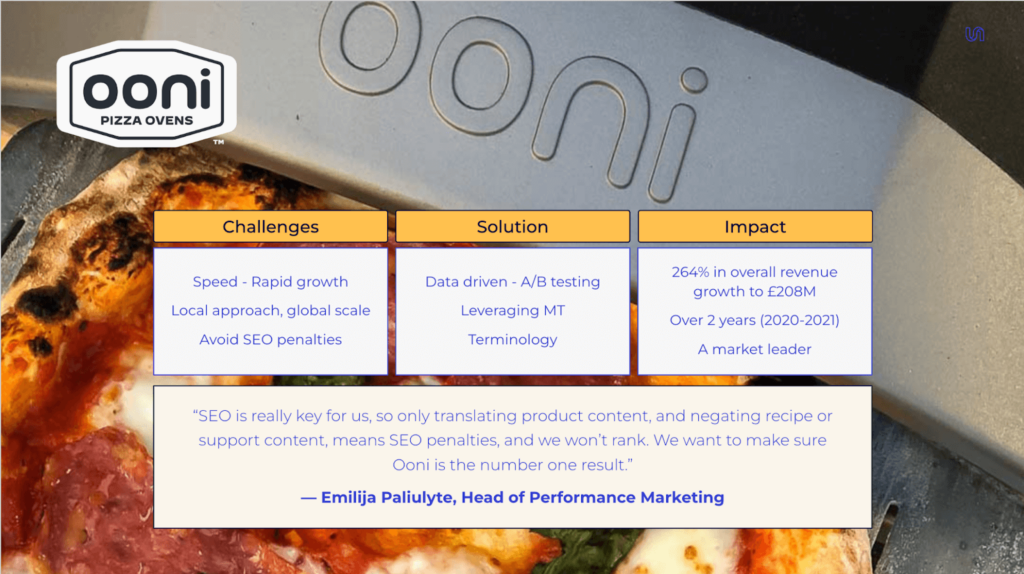
Ooni Pizza Ovens: Delivering the dough
Ooni Pizza Ovens had a fire lit under it: The team wanted to be number one in the market. To win its customers, it needed to speak their language, and fast: Ooni needed a local approach at a global scale.
Ooni identified that it needed to localize all its content items: From multilingual SEO and Google Ads, to customer support and checkout. To do this, Ooni took a methodical, data-driven approach. Ooni wasn’t really sure where to invest in localization. So, instead of moving into Italian and translating everything with the hope that it would resonate, it left the content and the digital ads in English, and only when it saw an uptick in engagement would it move to a localization process. To deliver the speed and the skill they required, Ooni deployed low-cost, low-touch translation tools.
Through its data-driven approach, Ooni deemed that deeper localization was required for German, French, and Italian language versions, but for the Nordic target languages, there was no localization required. It also discovered interesting nuances in its key terminology.
Ooni noticed that one of its English phrases, “wood-fired flavor,” was not perceived as authentic in Italy. Equally, “pizza pie,” quite recognizable in the US, was not a simple phrase in parts of Europe — in fact, it raised a few eyebrows along the way.
High levels of manual process = Low quality
“67% of marketers who said they were not confident at all in the quality of their translations, have a highly manual localization process.”
Anuvu, leading provider of in-flight entertainment content, struggled with the multiple manual touchpoints in its localization process. By adopting AI and automation, the functionality has been overhauled and the business has had a 20% reduction in turnaround time.
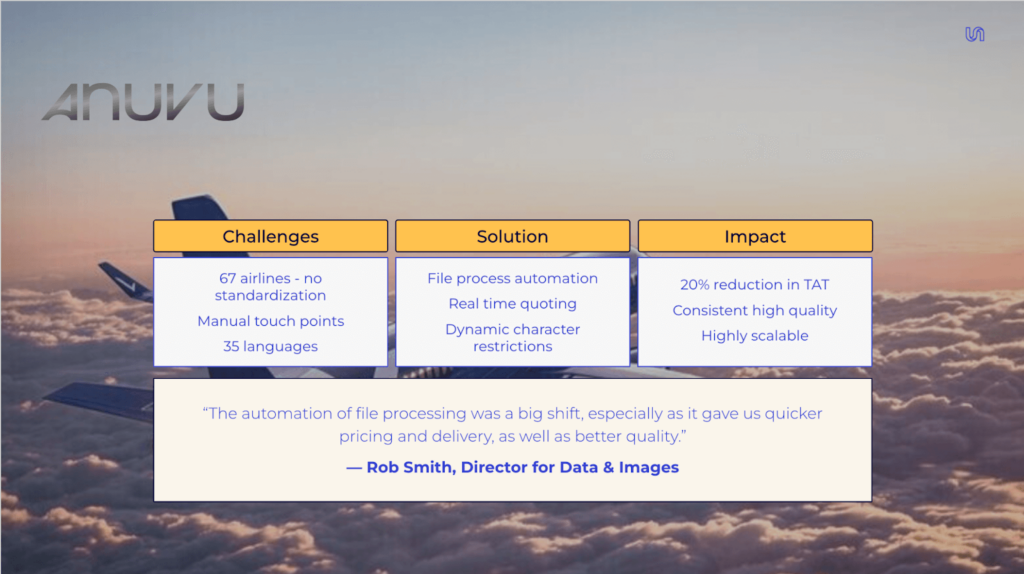
Anuvu: Providing sky-high customer experience
If you’ve recently flown internationally, you’re most likely familiar with Anuvu’s work, even if you don’t know the brand, says Adam. Anuvu works with 67 of the world’s top airlines to provide them with inflight entertainment — from UI content to movie descriptions. This wide client catalog posed a challenge: There was no standardization or templates across the airlines. Each airline had its own requirements and file format. So, when it came to translation services, it was handling thousands of spreadsheets, resulting in a very clunky process with lots of manual touchpoints.
Each airline could need its inflight entertainment translated into up to 35 languages. Anuvu desperately needed file process automation to eliminate as many manual touchpoints as possible. When you introduce automation, you let technology do the work and provide a streamlined workflow. This has an excellent knock-on effect: Real-time quoting. Now, rather than waiting for hours or even days, Anuvu receives a quote in real time. As well as knowing detailed pricing and delivery times, Anuvu had the confidence to build solid SLAs with the airlines.
Anuvu also had some specific issues around character restrictions. When you translate text, it expands and contracts depending on the language: For example, German text can take up 30% more space than English. Anuvu needed dynamic character restrictions on its translated text, so that if a movie description physically appears too long in certain languages, the translators have permission to shorten the text to fit the space.
At this volume of content, if you can automate as much as possible and reduce those manual touchpoints, it allows you to scale much more easily. Thanks to this scalable approach, Anuvu has the confidence to approach more airlines, to deliver more content across more languages.
Localization is impacting the wider business goals
“84% of marketers said localizing content is having a moderately to extremely positive impact on international revenue growth.”
Localization is evidently impacting the wider business goals, shares Adam, and what better way to examine this than with US success story Mouser Electronics? Mouser’s use of AI-powered machine translation paired with human translators boosted international growth from 15% to 60% in a five-year period.
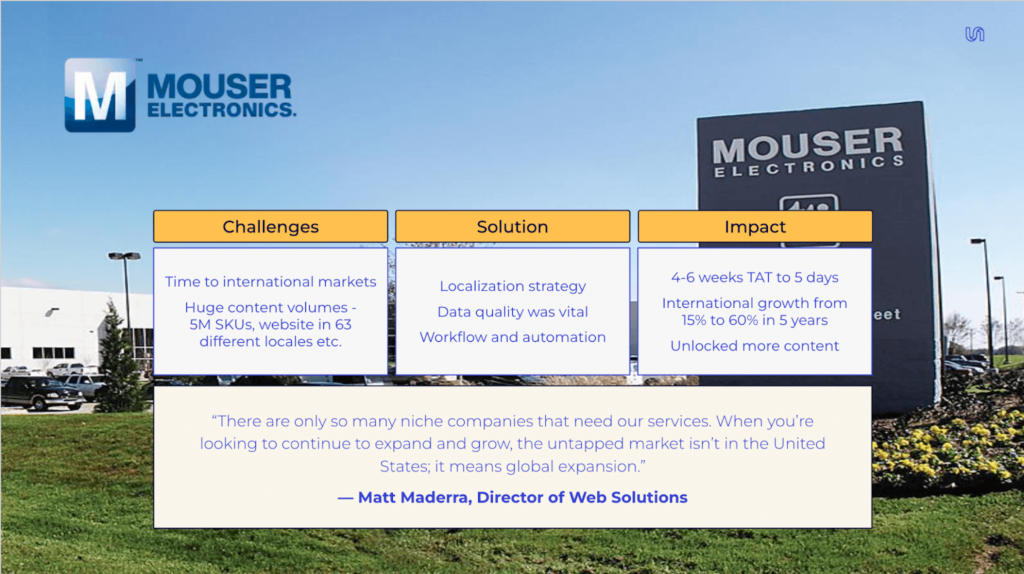
Mouser: Sparking international growth from a localization strategy
Mouser is an electronic component distributor. It had saturated the US market and knew the only way to grow business was to look international. Its catalog is over 5 million products, with very technical types of content, and needed localization into 63 different locales.
To understand its pain points, Unbabel assessed Mouser’s entire localization process, key stakeholders, and technology. From there, Unbabel could lay down a framework and a blueprint of how to improve to achieve Mouser’s business goal of international growth.
Quality was key to Mouser, given its technical content. Now, Mouser gets the power and speed of machine translation with human input for nuance. With this hybrid combination, content translation turnaround has reduced from 4 – 6 weeks to five days, with no effect on the high quality. Another add-on was cost reduction: By reducing costs by 60%, Mouser has been able to unlock more content. It now translates six times more content, helping engage its customers even more.
Key takeaways
There were lots of questions from the audience, including from one member who was keen to hit the ground running on their localization process:
“What’s one action item that somebody can do straight away to show the value of having come to this presentation?”
Adam was keen to help, suggesting that if you’re in an organization that’s already localizing, the best step is to find your localization team and become friends with them. Collaboration is key, which nicely concluded Adam’s four key takeaways.
The first takeaway: No two organizations are the same. There will be differences across workflows, technology, and industry, you may find some similarities, but down in the details of style guides and terminology, Adam shares that he has never seen two identical style guides.
There are three places where Adam most commonly sees challenges in the marketing localization world: Process flow, technology, and data. So, Adam’s final three takeaways are for businesses to think about localization upstream and embrace technology — AI machine translation and automation — to be effective internationally and to scale. Lastly, Adam recommends companies are data-driven. Localize for a reason: Identify what metrics you’re measuring to find which content is resonating with particular markets. Then, use that data to support a business case to receive more budget for localization.
Ooni Pizza Ovens, Anuvu, and Mouser localize their content to meet the demands of their global audience. See how other global marketers are localizing their content: Read Unbabel’s Global Trends in Marketing Localization 2023 Report.












